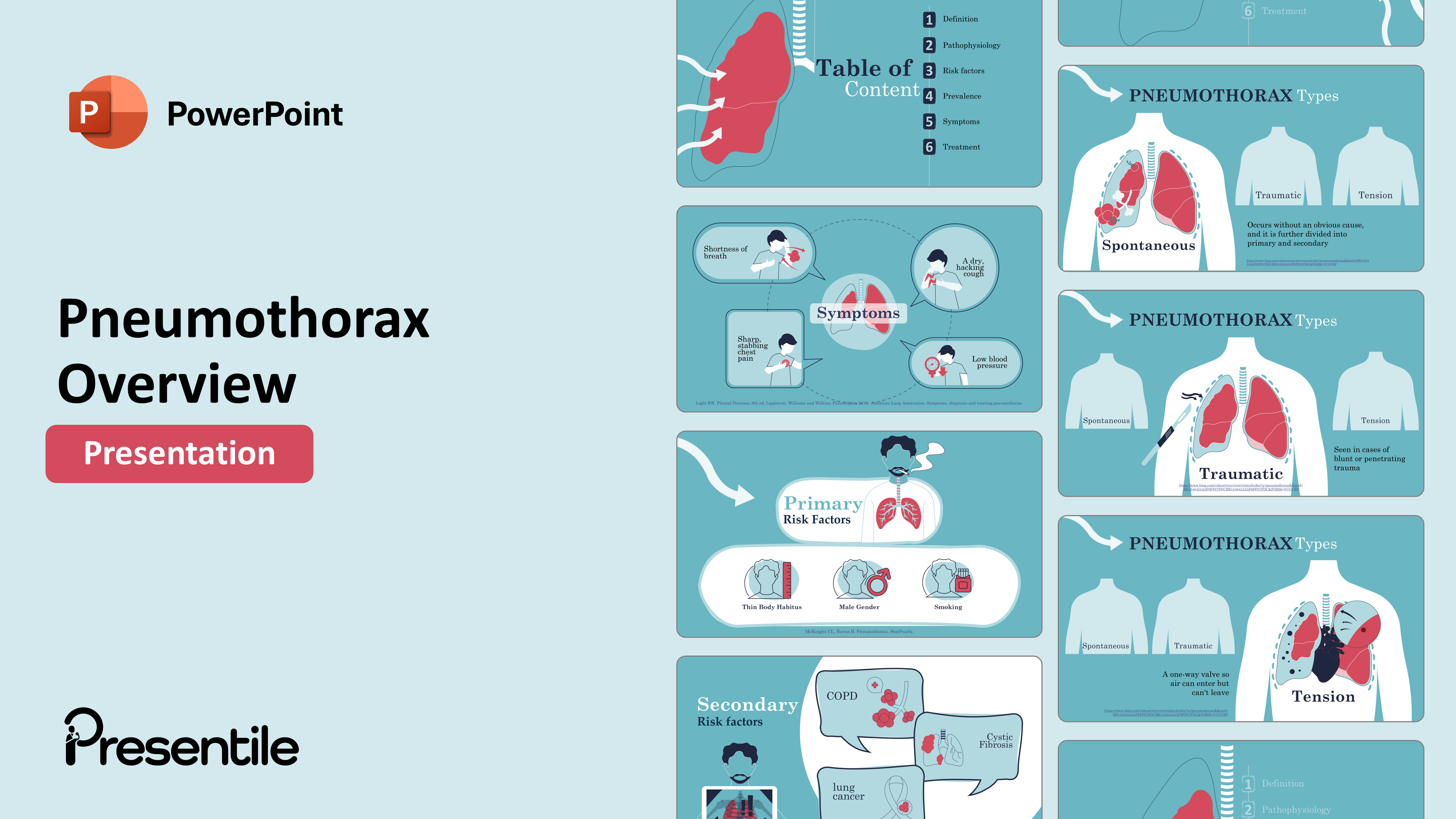
Content of
Pneumothorax Overview Presentation
Slide 1: Introduction to Pneumothorax
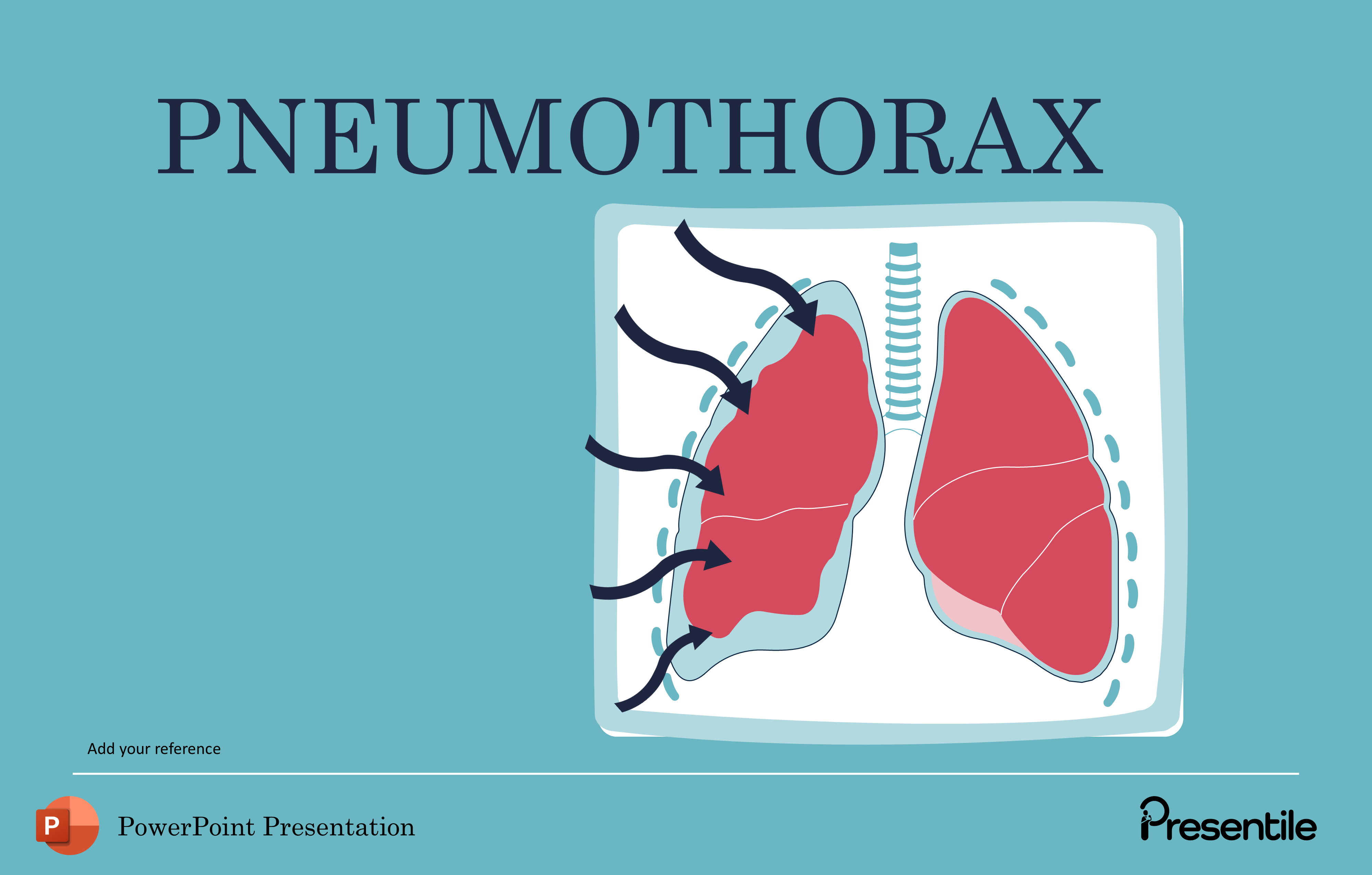
- This title slide introduces the comprehensive presentation on Pneumothorax (Collapsed Lung).
- The design features a clear, anatomical illustration showing the chest cavity.
- The image specifically highlights the characteristic pathology: air entering the pleural space (indicated by arrows) and causing one of the lungs to partially collapse.
- The large, bold title "PNEUMOTHORAX" is instantly recognizable, effectively communicating the primary topic and setting a focused, medical tone for the detailed content to follow.
Slide 2: Table of Content
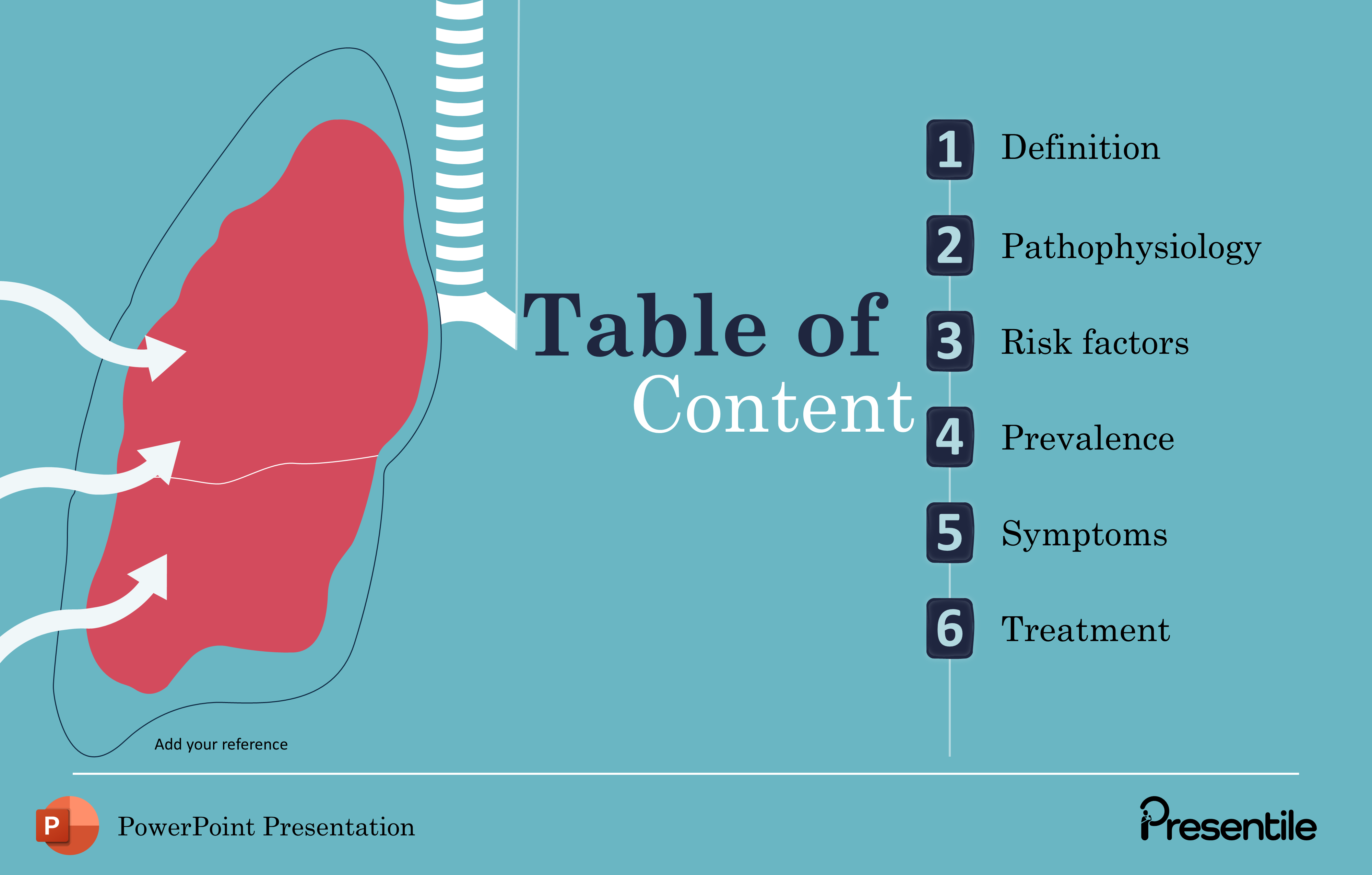
- This slide serves as the agenda, outlining the six key sections of the presentation.
- The list clearly sets audience expectations by detailing the structured flow of information.
- The topics covered include the Definition, Pathophysiology, Risk factors, Prevalence, Symptoms, and Treatment of pneumothorax.
Slide 3: Section Focus: Definition of Pneumothorax
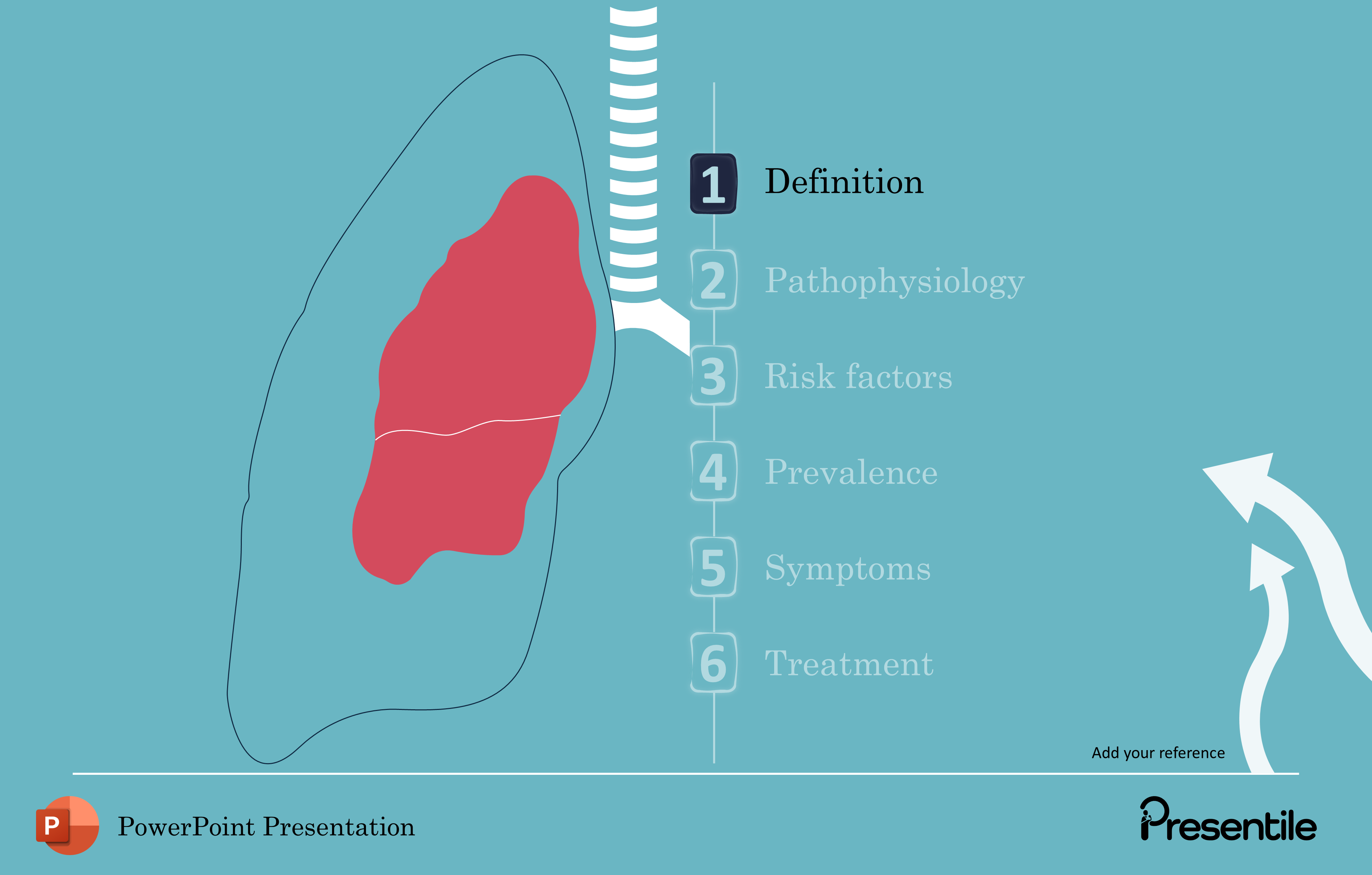
- This slide serves as a transition, highlighting the first main section of the presentation: the Definition.
- The sequential numbering system from the Table of Content is utilized, with the number '1' (Definition) prominently boxed and highlighted to draw the audience's focus.
- The visual emphasis signals that the presentation is now moving from the overview to the core content, preparing the audience for a clear, concise explanation of what pneumothorax is.
Slide 4: Defining Pneumothorax

- This slide provides the clinical definition of Pneumothorax, accompanied by a clear visual explanation.
- The main text clearly defines the condition as the "Accumulation of air in the pleural space, the area between the lungs and the chest wall."
- An anatomical diagram of the chest includes a magnified circle, vividly illustrating the air (shown as black particles) trapped between the collapsed lung tissue and the chest wall lining.
Slide 5: Section Focus: Pathophysiology of Pneumothorax
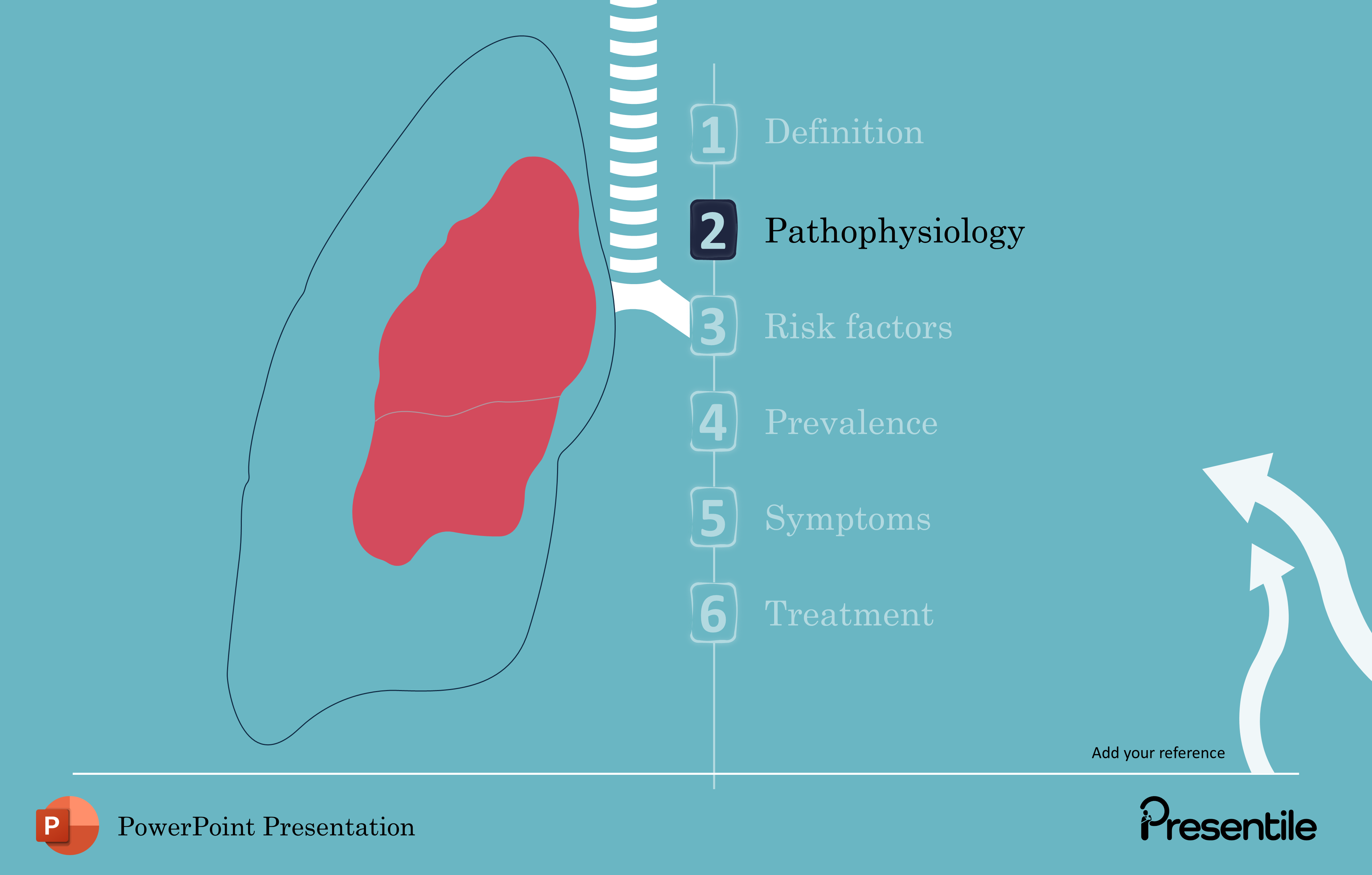
- This slide serves as a transitional header, shifting the presentation's focus to the mechanism of the condition.
- The sequential agenda highlights the second main topic: '2' Pathophysiology.
Slide 6: Spontaneous Pneumothorax Explained
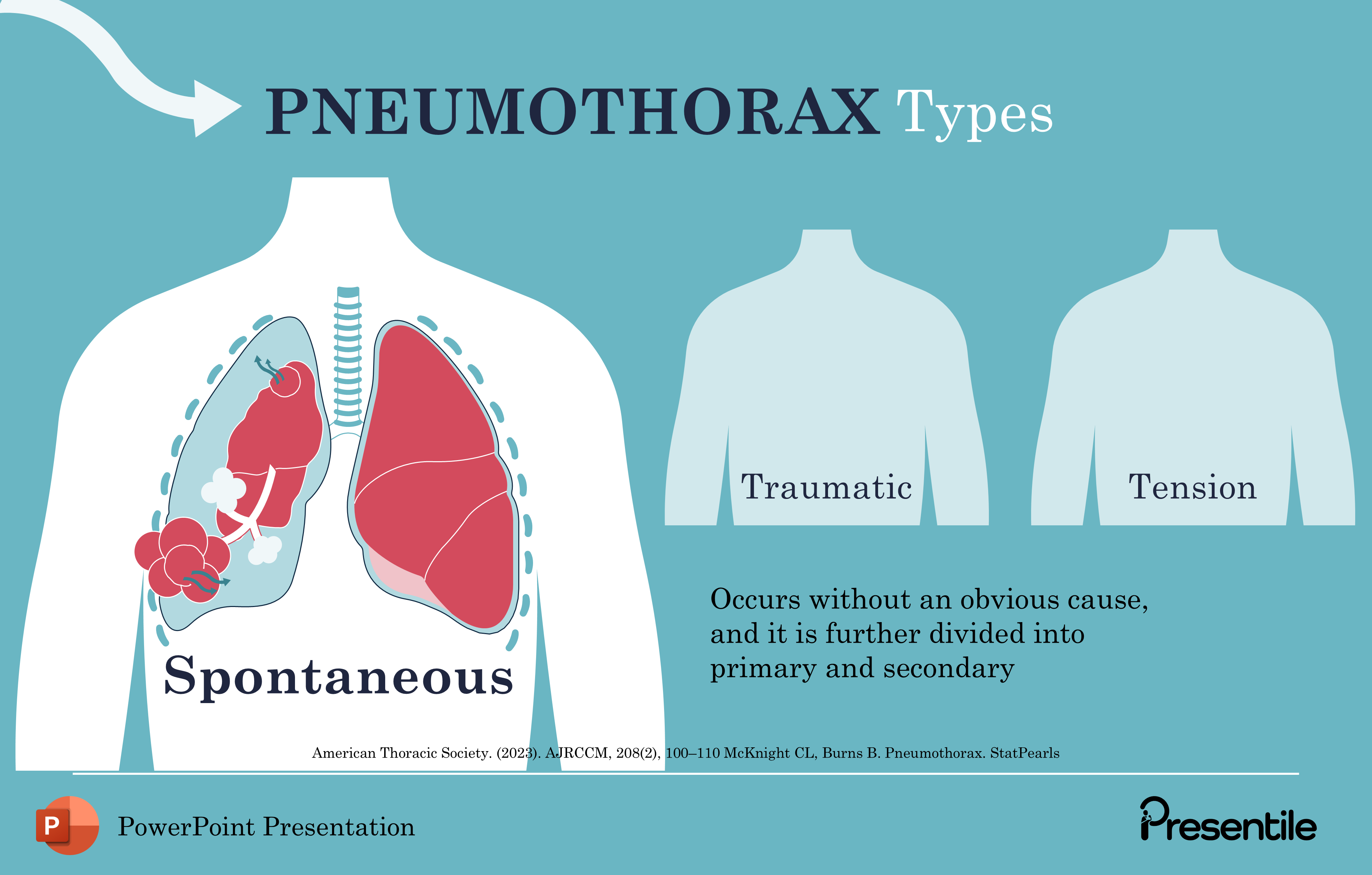
- This slide categorizes Pneumothorax into its three main clinical types.
- It uses a distinct visual layout to introduce: Spontaneous, Traumatic, and Tension pneumothorax.
- The slide focuses on the most common type, Spontaneous Pneumothorax, explaining that it "Occurs without an obvious cause, and it is further divided into primary and secondary."
- The central anatomical illustration clearly depicts the Spontaneous type with lung damage.
Slide 7: Traumatic Pneumothorax Explained
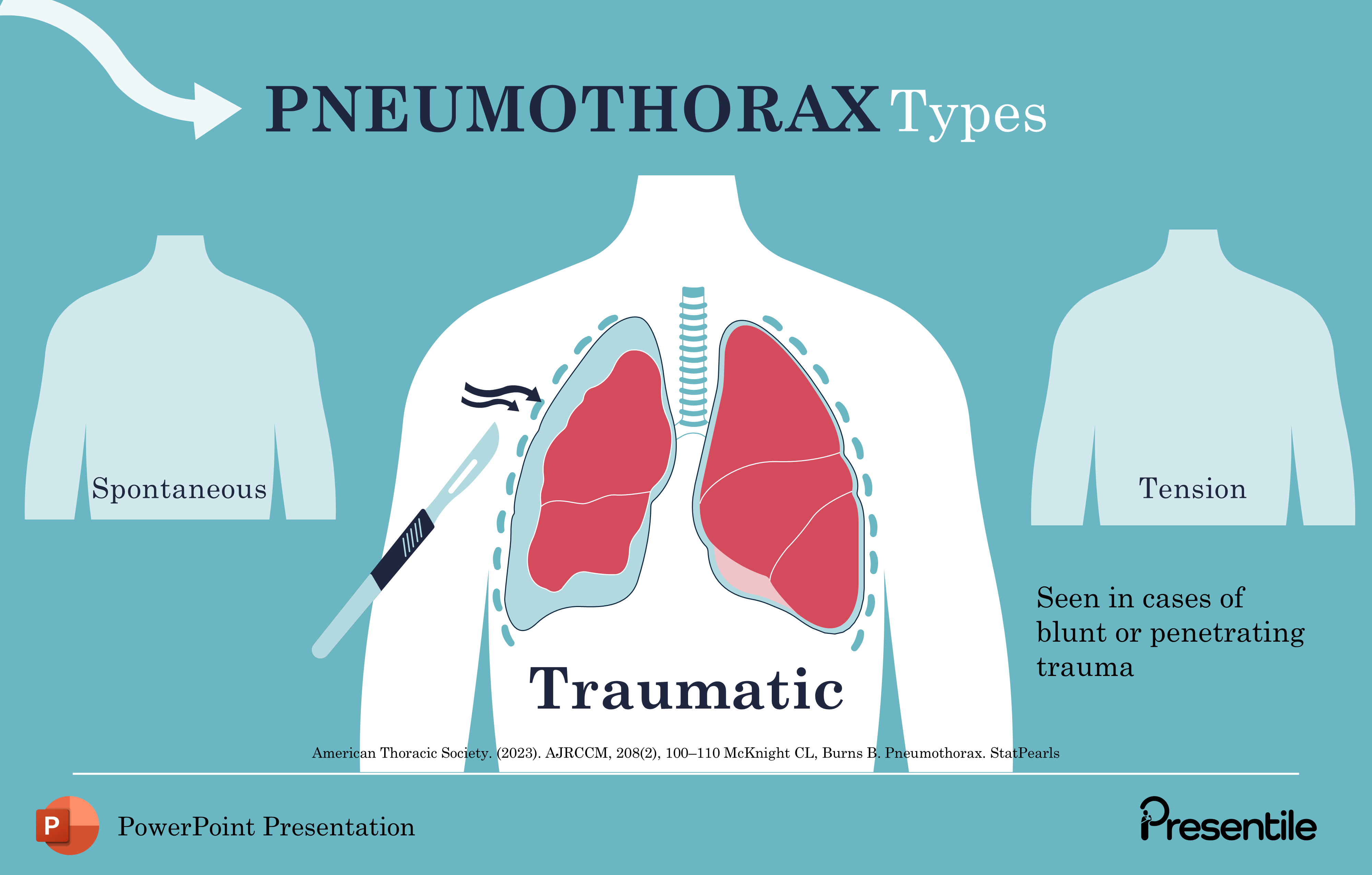
- This slide focuses on Traumatic Pneumothorax, detailing its primary cause.
- It highlights the word "Traumatic" and provides a clear description: it is "Seen in cases of blunt or penetrating trauma."
- The anatomical illustration, featuring a stylized scalpel or sharp object near the chest wall, vividly represents the external injury that leads to air entering the pleural space.
- This provides a clear visual and textual distinction from the spontaneous type, emphasizing the role of injury in this specific category of collapsed lung.
Slide 8: Understanding Tension Pneumothorax
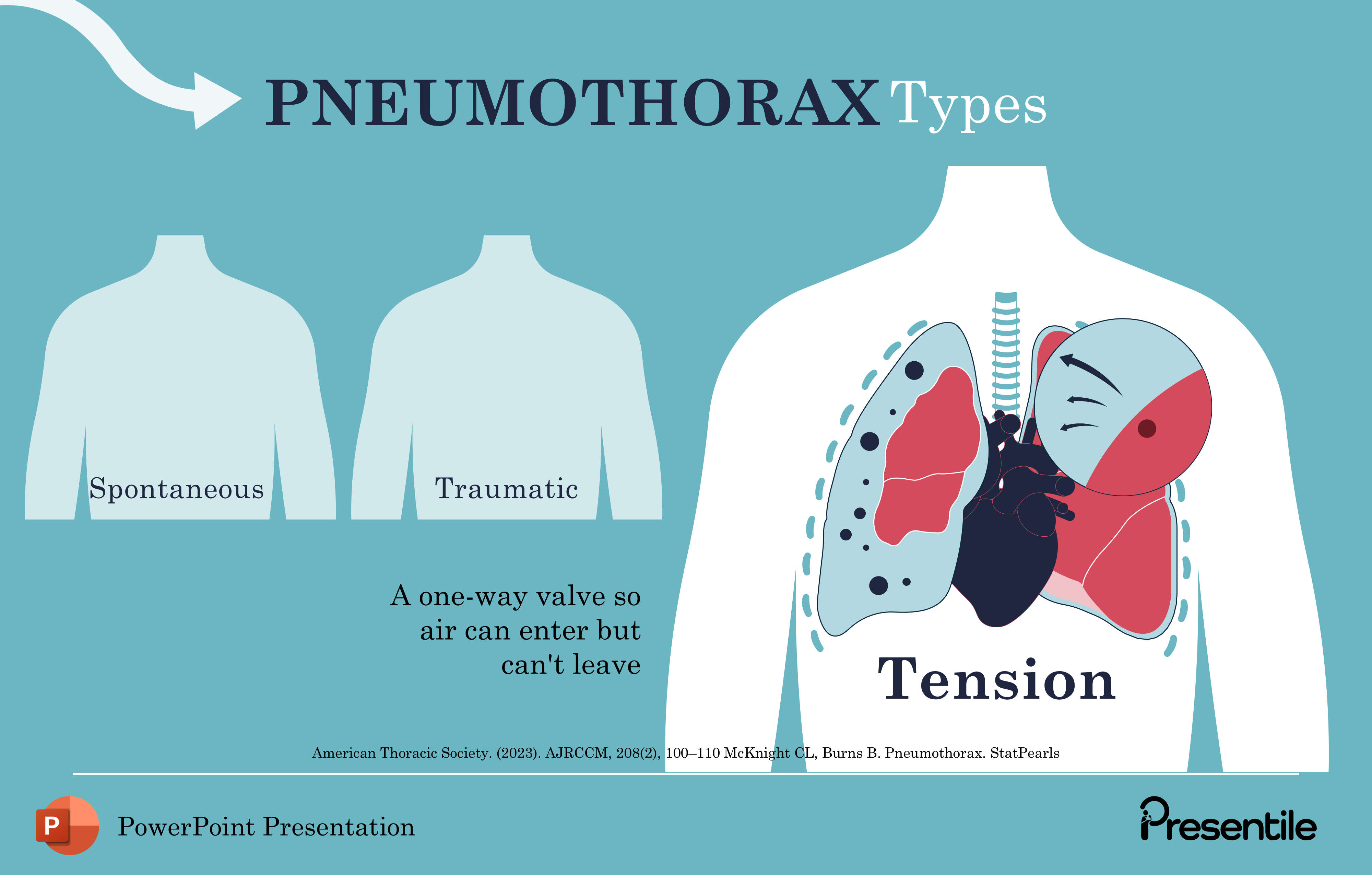
- This slide focuses on the life-threatening condition of Tension Pneumothorax.
- It visually highlights the chest cavity, showing the severe collapse of the lung and the resulting shift of the heart and mediastinal structures to the opposite side.
- The key text explains the mechanism: it acts as "A one-way valve so air can enter but can’t leave."
- This persistent trapping of air causes pressure to rapidly build up, leading to critical cardiopulmonary compromise, emphasizing the urgent nature of this specific type of pneumothorax.
Slide 9: Section Focus: Risk Factors for Pneumothorax

- This slide serves as a transitional header, shifting the presentation's focus to the factors that increase the likelihood of developing Pneumothorax.
- The sequential agenda highlights the third main topic: '3' Risk factors.
- The prominent highlighting of this section prepares the audience for a discussion of the populations, conditions, and environmental elements that predispose individuals to a collapsed lung.
- This logical transition maintains the clear structure of the presentation.
Slide 10: Primary Risk Factors for Pneumothorax

- This slide details the three primary, non-disease-related risk factors for developing spontaneous pneumothorax.
- It clearly identifies and illustrates these factors in separate bubbles: Thin Body Habitus (tall, thin individuals), Male Gender, and Smoking.
- The inclusion of an image of a man smoking with an anatomical overlay of the lungs immediately connects the habit to the respiratory system.
Slide 11: Secondary Risk Factors for Pneumothorax
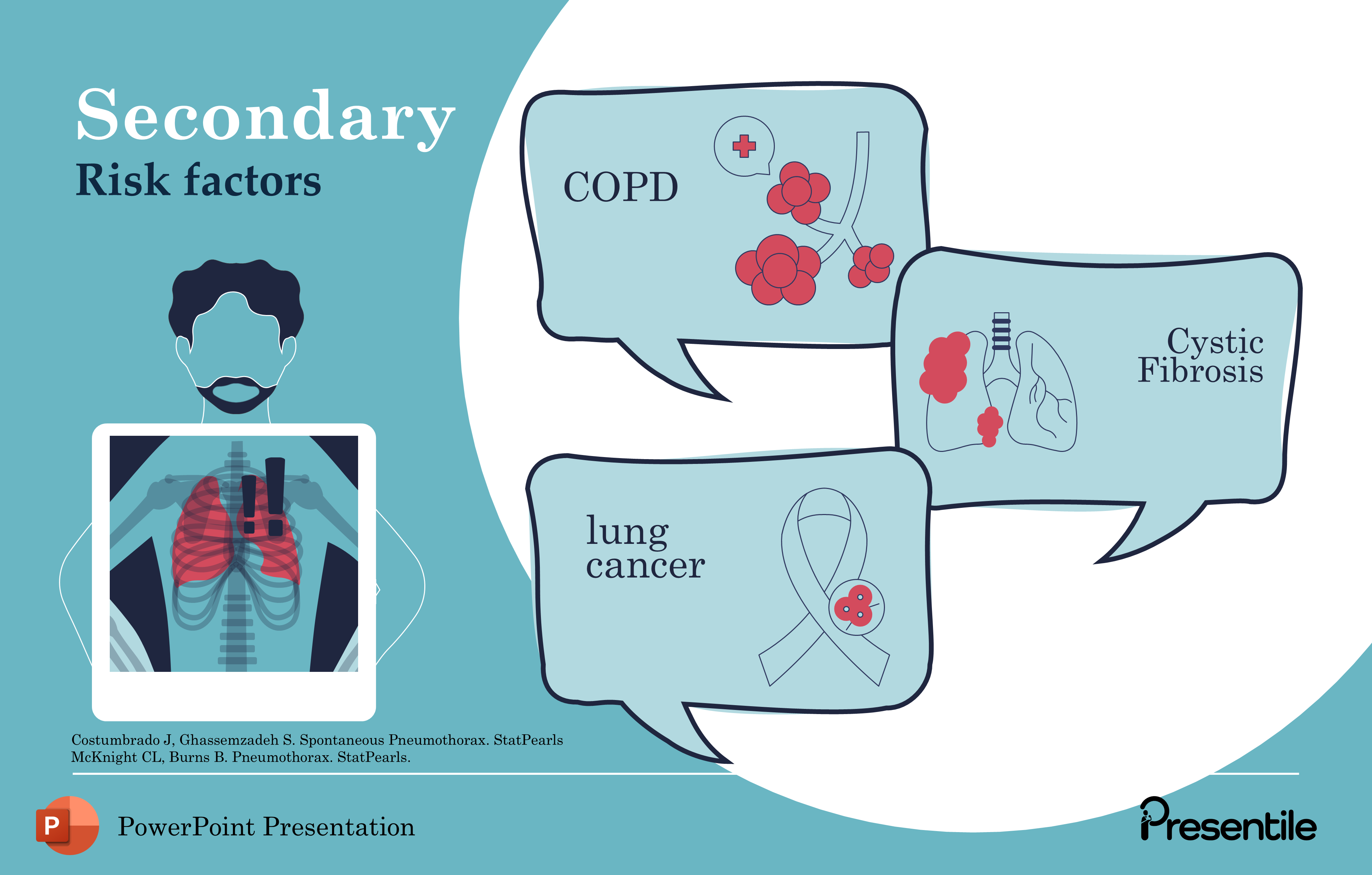
- This slide details the secondary risk factors, focusing on pre-existing medical conditions that increase the risk of pneumothorax.
- The central text identifies this section as "Secondary Risk factors".
- Three common chronic lung diseases are presented in conversational bubbles:
- COPD (Chronic Obstructive Pulmonary Disease): Illustrated with damaged alveoli, showing a connection to chronic structural lung changes.
- Cystic Fibrosis: Depicted with an image of a chest and respiratory system, representing the systemic effects of the disease.
- Lung Cancer: Symbolized by a ribbon and a tumor, indicating tissue damage and potential for rupture.
Slide 12: Section Focus: Prevalence of Pneumothorax
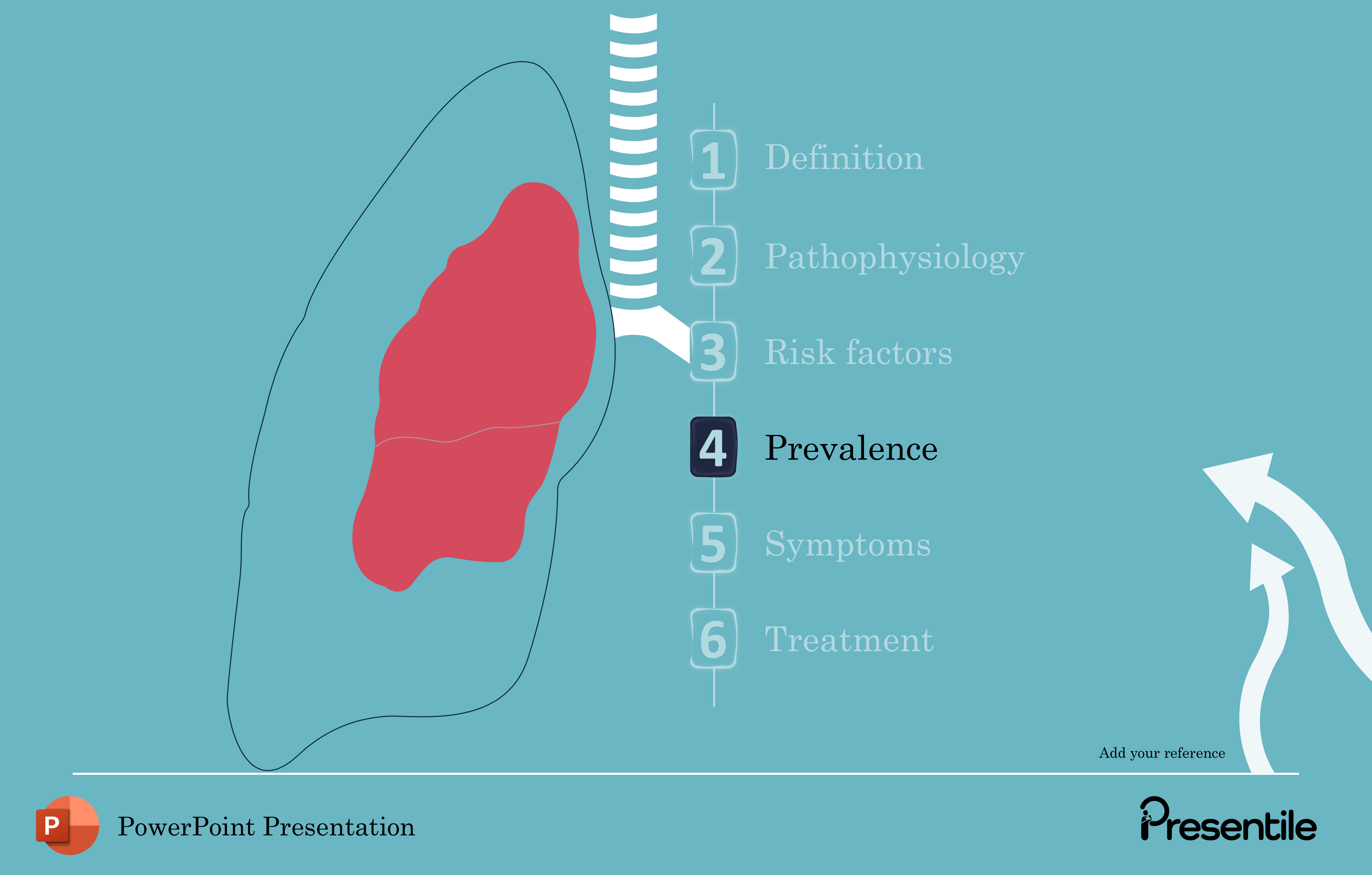
- This slide serves as a transitional header, shifting the presentation's focus to the frequency and distribution of Pneumothorax.
- The sequential agenda highlights the fourth main topic: '4' Prevalence.
- The prominent highlighting of this section indicates the start of a discussion on epidemiological data—specifically, how often the collapsed lung condition occurs in the general population.
Slide 13: Prevalence – Gender Disparity in Pneumothorax
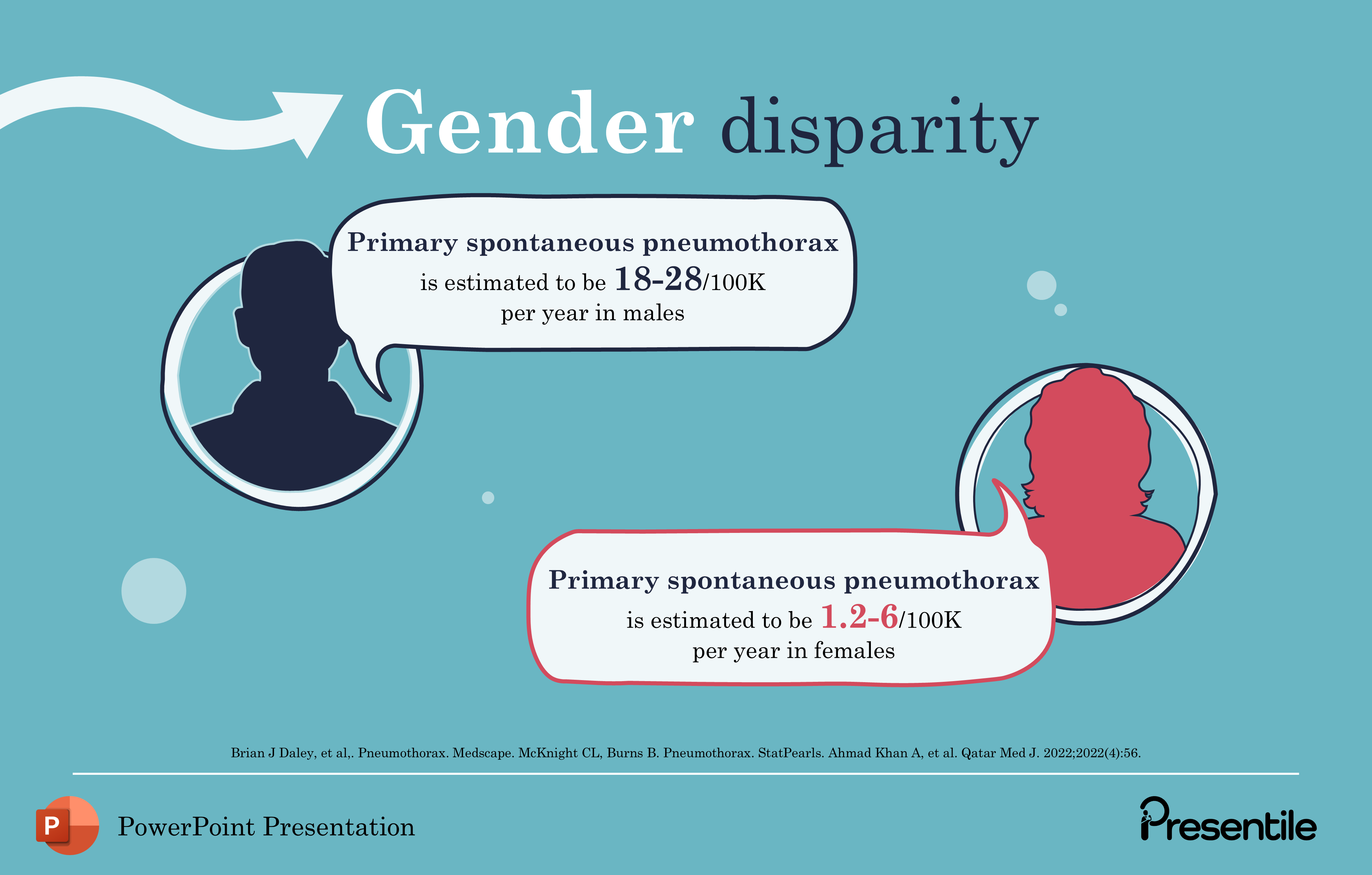
- This slide details the epidemiological gender disparity in Primary Spontaneous Pneumothorax (PSP).
- The chart uses two conversational bubbles to clearly contrast the incidence rates between males and females.
- The text states that PSP is estimated to be 18-28/100K per year in males, while the rate in females is significantly lower, estimated at 1.2-6/100K per year.
Slide 14: Recurrence Rate of Pneumothorax

- This slide provides critical statistical data on the risk of a repeat collapsed lung episode.
- It clearly highlights the Recurrence rate using a circular arrow graphic around the lung anatomy, visually representing a cycle of re-occurrence.
- The key figures are presented in two speech bubbles:
- The first point notes that most recurrence occurs within the 1st year, underscoring the high-risk period immediately following the initial event.
- The second point provides the wide incidence range, stating that the recurrence risk is estimated to be from 25% to 50%.This data is essential for patient counseling and long-term management strategies for pneumothorax.
Slide 15: Section Focus: Clinical Pictures of Pneumothorax

- This slide serves as a transitional header, shifting the presentation's focus to the clinical signs and symptoms of Pneumothorax.
- The sequential agenda highlights the fifth main topic: '5' Clinical pictures (another term for Symptoms).
Slide 16: Key Symptoms and Clinical Presentation of Pneumothorax

- This slide details the four most critical symptoms a patient with Pneumothorax will experience.
- The symptoms are presented in conversational bubbles arranged around a central anatomical illustration of the lungs, showing the affected side.
- The four key symptoms are:
- Shortness of breath: Represented by a person struggling to breathe, this is the primary complaint due to reduced lung volume.
- A dry, hacking cough: Illustrated by a person coughing and clutching their chest, signaling irritation in the respiratory system.
- Sharp, stabbing chest pain: Shown as localized pain in the chest, often described as pleuritic (worsens with breathing).
- Low blood pressure: Indicated by a blood pressure graphic with a downward arrow, which is particularly relevant in severe cases like Tension Pneumothorax.
Slide 17: Complications: Pulmonary Edema, Pneumopericardium, and Pneumohemothorax

This slide details three serious potential complications of Pneumothorax and its treatment. A prominent warning symbol on the left emphasizes the gravity of these conditions.
- Pulmonary edema: Explained as fluid accumulation in the lungs following treatment for pneumothorax, which is a known risk of rapid re-expansion.
- Pneumopericardium: Defined as when air enters the cavity around the heart, which can impair cardiac function.
- Pneumohemothorax: Described as when blood enters the chest cavity, often associated with traumatic pneumothorax where a vessel is damaged.
Slide 18: Case Diagnosis – Confirming Pneumothorax with Chest X-ray
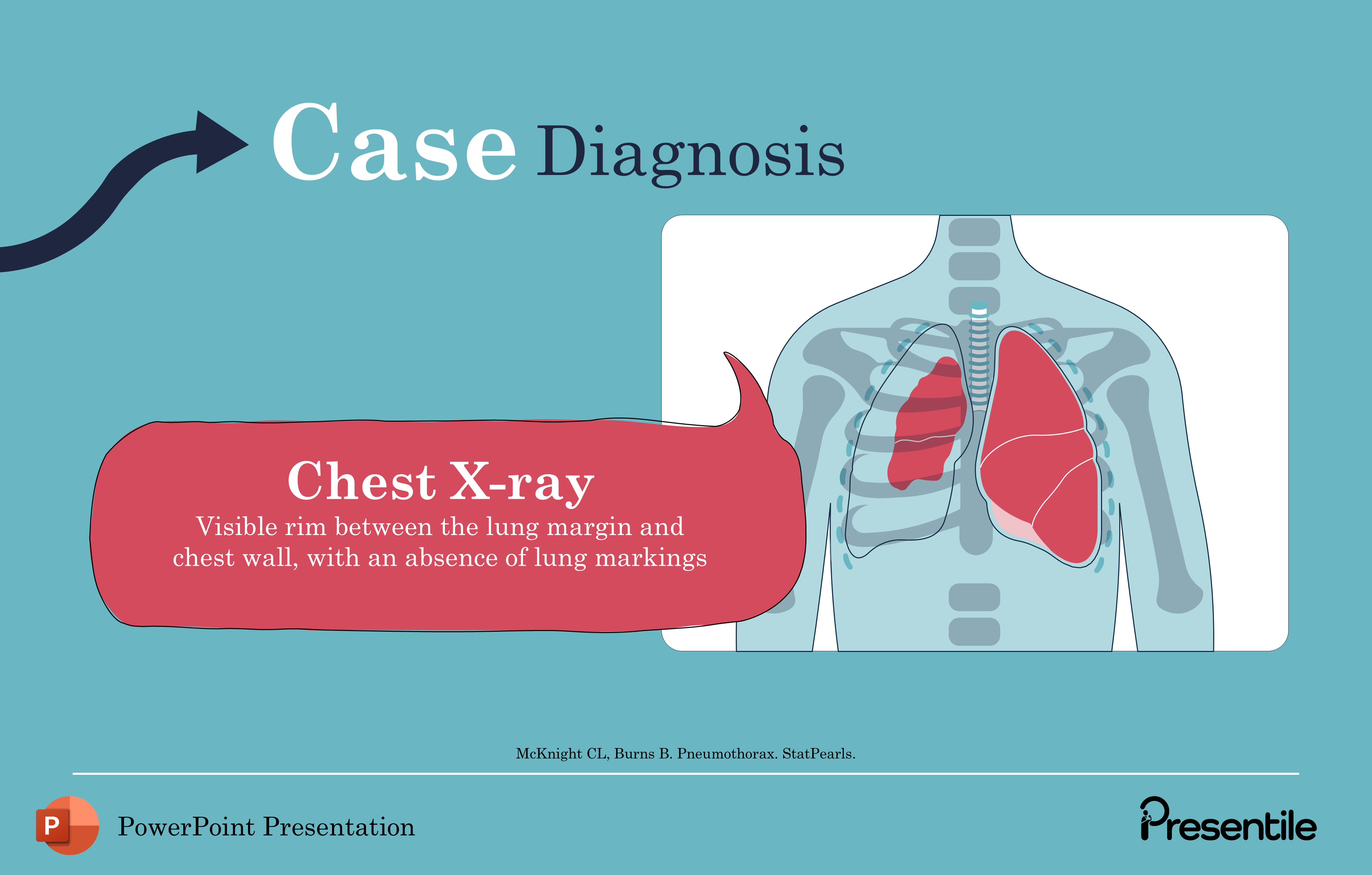
- This slide focuses on the primary diagnostic tool for Pneumothorax: the Chest X-ray.
- The visual shows a clear anatomical X-ray of the chest cavity.
- The description in the speech bubble explains the key finding: a "Visible rim between the lung margin and chest wall, with an absence of lung markings."
- This visual evidence of air trapped in the pleural space is the definitive radiological sign used to confirm a collapsed lung.
Slide 19: Differential Diagnosis of Chest Conditions

- This slide provides a comparative breakdown to distinguish Pneumothorax from other chest pathologies.
- It uses four distinct panels, each with an anatomical illustration of the chest, centered around the heading "Differential Diagnosis."
- Pleural Effusion: Clearly defined as the "Collection of fluid in the pleural space."
- Hemothorax: Described as the "Collection of blood in the pleural space."
- Pneumothorax: Re-emphasized as the "Collection of air in the pleural space."
- Tension Pneumothorax: Highlighted by its mechanism, "A one-way air leak into the pleural space," and its visible effect on the heart and mediastinum.
Slide 20: Section Focus: Treatment of Pneumothorax
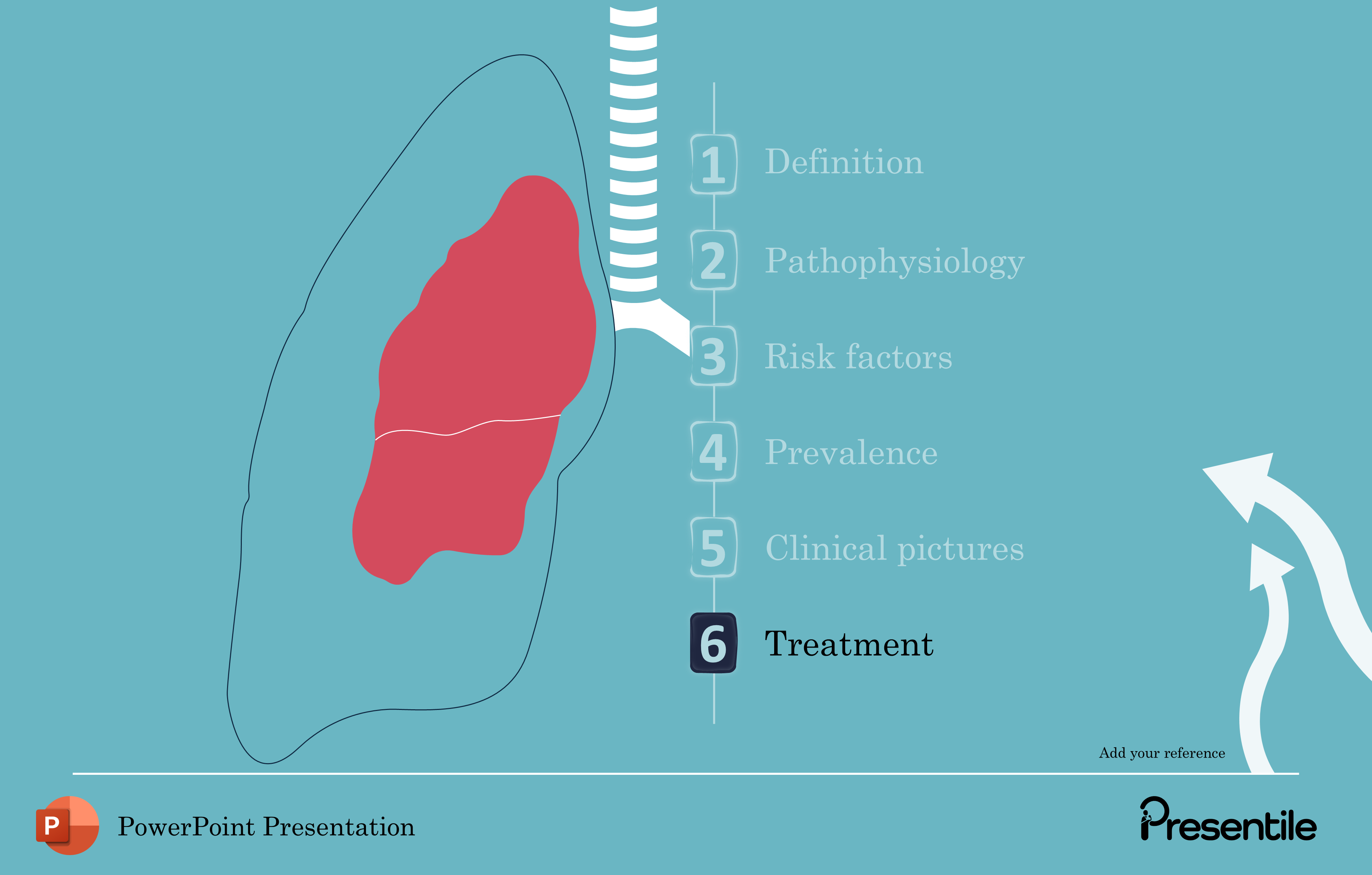
- This slide serves as a transitional header, shifting the presentation's focus to the management and therapy options for Pneumothorax.
- The sequential agenda highlights the sixth and final main topic: '6' Treatment.
Slide 21: Treatment Focus: Chest Tube Drainage
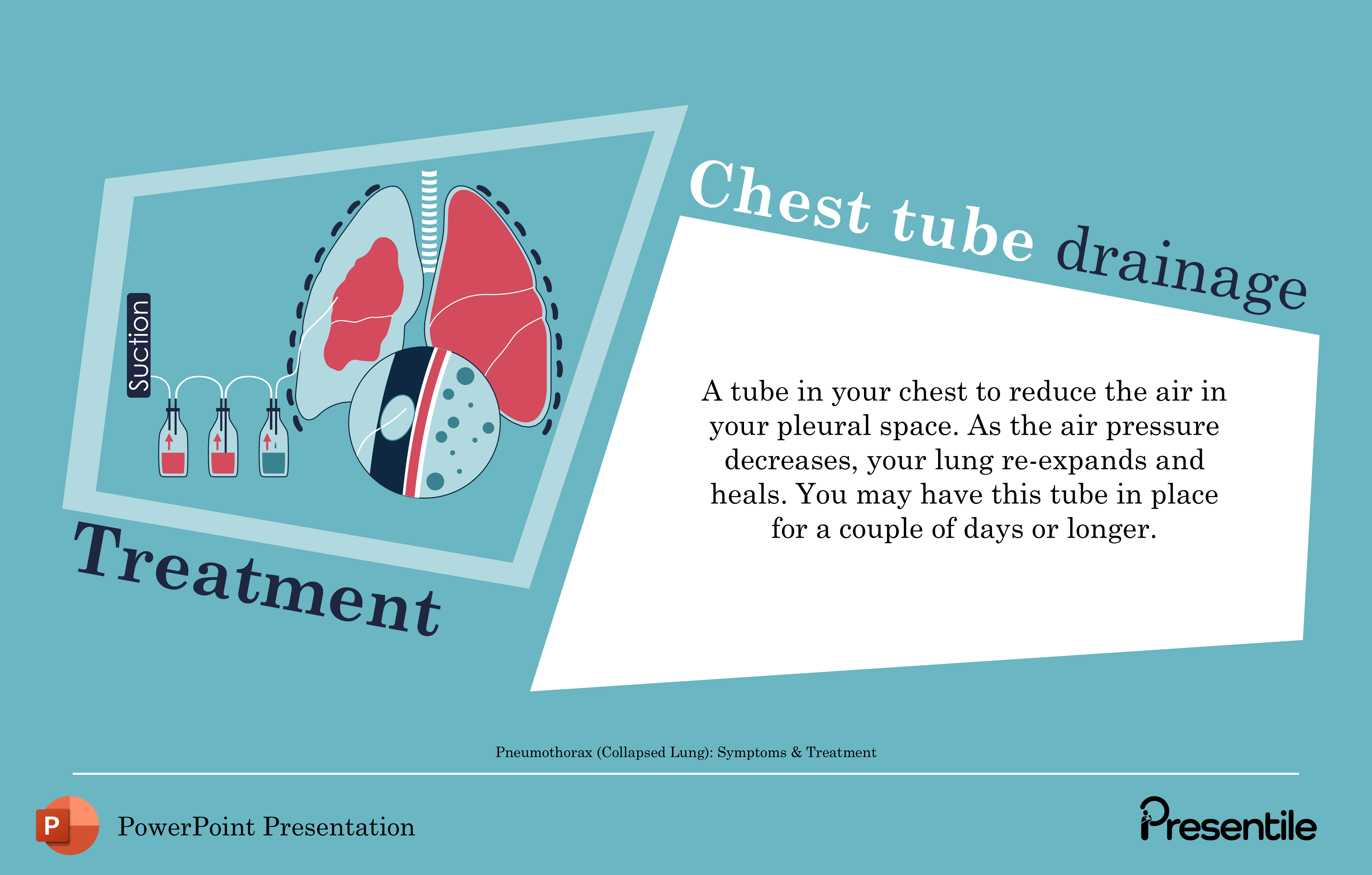
- This slide introduces Chest Tube Drainage, a common interventional treatment for Pneumothorax.
- The visual provides a clear anatomical diagram showing a chest tube inserted into the pleural space and connected to a water-seal drainage system with suction applied.
- The description explains the core function: "A tube in your chest to reduce the air in your pleural space. As the air pressure decreases, your lung re-expands and heals."
- It also adds the key clinical detail that the tube "may have this tube in place for a couple of days or longer," informing the audience about the expected duration of the procedure.
Slide 22: Comprehensive Treatment Options for Pneumothorax

This slide provides a clear, three-step hierarchy of treatment options for Pneumothorax, ranging from monitoring to invasive surgery.
It uses large, numbered circles to delineate each approach:
- Observation: Described as "Monitoring with chest X-rays until the excess air is completely absorbed," suitable for small, stable pneumothorax.
- Nonsurgical Repair (Chemical Pleurodesis or Bronchoscope Repair): This option is indicated "If a chest tube doesn’t re-expand the lung, to close the air leak (bronchoscope)."
- Surgery (Video-Assisted Thoracoscopic Surgery or VATS): Reserved "For large pneumothoraxes or when there is a risk of a collapsed lung becoming chronic."
Slide 23: Thank You and Conclusion
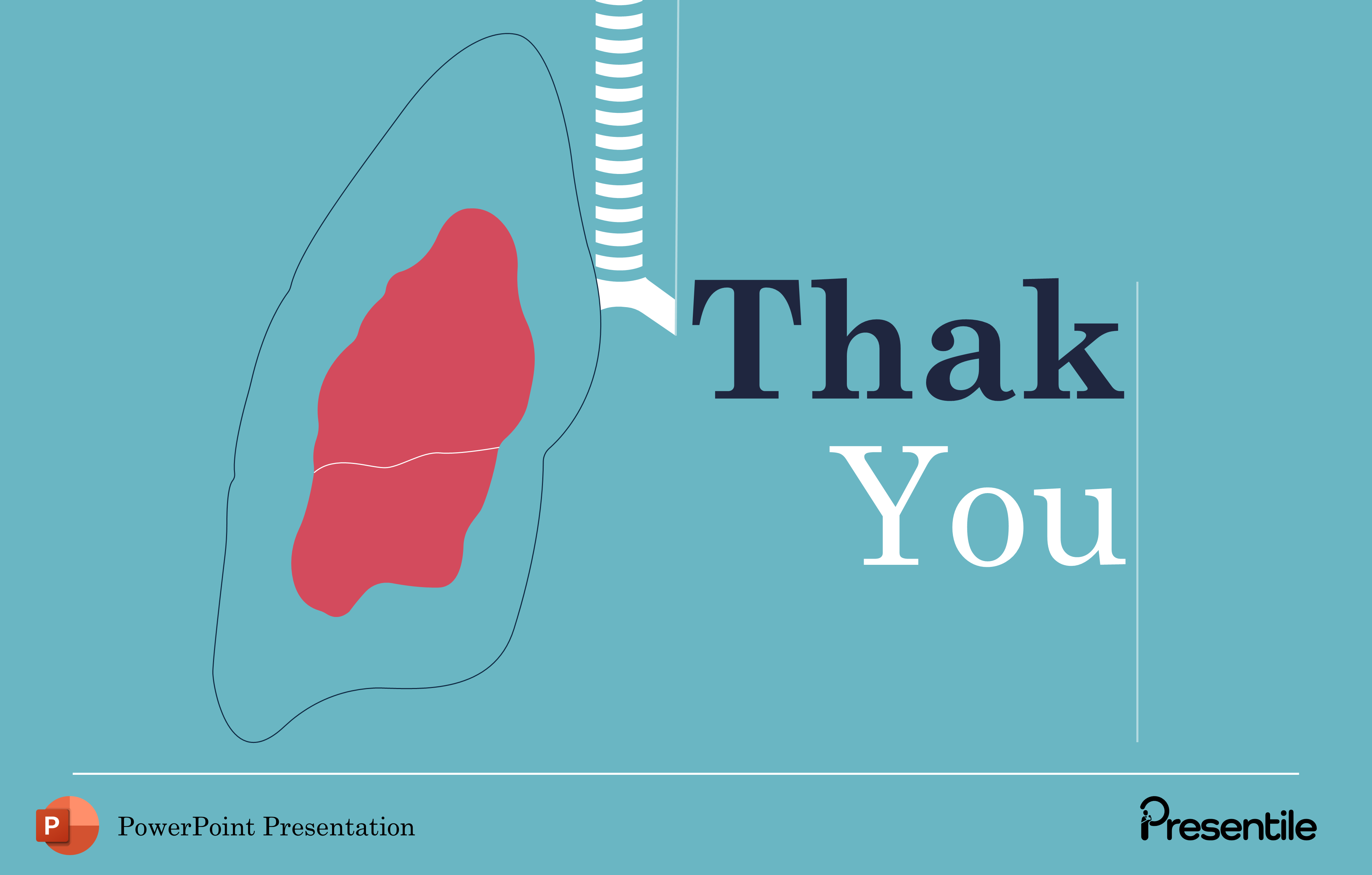
- This slide serves as a polite and visually consistent conclusion to the Pneumothorax presentation.
- The simple, bold text "Thank You" provides a clear closing message.
- The stylized illustration of the collapsed lung on the left ties the final slide back to the presentation's core subject matter, maintaining the overall design theme.
Features of
Pneumothorax Overview Presentation
- Fully editable in PowerPoint
- All graphics are in vector format
- Medically Referenced information and data
Specifications
 Slides count:
Slides count: Compatible with:Microsoft PowerPoint
Compatible with:Microsoft PowerPoint File type:PPTX
File type:PPTX Dimensions:16:9
Dimensions:16:9
Elevate Your Work with Our Innovative Slides
Thank you! Your submission has been received!
Oops! Something went wrong while submitting the form.
No items found.




